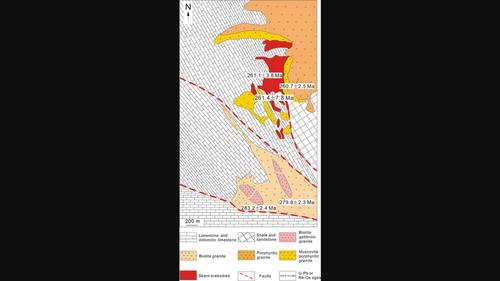与W矿化有关的极分选岩浆:来自南天山造山带Lyangar W - Mo矿床的证据
IF 0.8
4区 地球科学
Q3 GEOLOGY
引用次数: 0
摘要
钨(W)矿床通常与岩浆热液流体从高硅花岗岩(SiO2占70%)中析出有关。然而,W相关的高硅花岗质岩浆是由变质沉积岩的部分熔融产生的,还是由高度的分离结晶产生的,仍然存在争议。本文介绍了与乌兹别克斯坦南天山造山带Lyangar W - Mo矽卡岩矿床有关的岩体的年代学和地球化学资料。新的U-Pb锆石年龄数据表明,该地区暴露的主要侵入岩为约280 Ma的黑云母辉长闪长岩和黑云母花岗岩,以及约260 Ma的斑岩花岗岩和白云母斑岩花岗岩。矽卡岩和矿体辉钼矿的Re - Os加权年龄分别为261.4±7.8 Ma和261.1±3.8 Ma。结合野外接触,确认白云母斑岩花岗岩与W矿化有成因关系。从斑岩花岗岩到白云母斑岩花岗岩的逐渐过渡,相似的矿物组合和地球化学变化表明它们是同岩浆作用的,斑岩花岗岩代表演化程度较低的成员。流纹岩- melt模型进一步证实,白云母斑岩花岗岩可由斑岩花岗岩岩浆的高度分馏结晶(~33%,包括~1.2%黑云母、~27%斜长石、~2%碱长石、~0.21%铁钛氧化物和~2.7%角闪洞)形成。根据ƐHf(t)正值(+3.03 ~ +6.02)、高SiO2含量和CIPW特征,认为该斑状花岗岩是由幼玄武质烃源岩在16 kbar、850 ~ 1000℃的低pH2O条件下脱水熔融形成的。研究表明,花岗质岩浆的极端分异结晶对花岗质熔体中W的富集起着重要作用。本文章由计算机程序翻译,如有差异,请以英文原文为准。

Extremely fractionated magmas linked with W mineralization: Evidence from the Lyangar W‐Mo deposit, South Tianshan Orogenic Belt
Tungsten (W) deposits are commonly related to the exsolution of magmatic‐hydrothermal fluids from high‐Si granites (SiO2 > 70%). However, whether the W‐related high‐Si granitic magma is produced via partial melting of metasedimentary source rocks or by high degree of fractional crystallization remains controversial. Here we present new geochronological and geochemical data on the intrusions associated with the Lyangar W‐Mo skarn deposit in the Southern Tianshan Orogenic Belt, Uzbekistan. Our new U–Pb zircon age data show that the major intrusion exposed in the region are ca. 280 Ma biotite gabbroic diorite and biotite granite and about 260 Ma porphyritic granite and muscovite porphyritic granite. The molybdenite grains in the skarn rocks and orebodies show weighted Re‐Os ages of 261.4 ± 7.8 Ma and 261.1 ± 3.8 Ma, respectively. In combination with the field contact, we confirm that the muscovite porphyritic granite is genetically related to the W mineralization. The gradual transition from the porphyritic granite to muscovite porphyritic granite, similar mineral assemblages and geochemical variations indicate that they are co‐magmatic, and that the porphyritic granite represents less evolved member. Rhyolite‐MELTS modeling further reinforces that the muscovite porphyritic granites can be produced by high degree of fractional crystallization (~33%, including ~1.2% biotite, ~27% plagioclase, ~2% alkali‐feldspar, ~0.21% Fe‐Ti oxides, and ~2.7% amphibole) of the porphyritic granite magma. On the basis of the positive ƐHf(t) values (+3.03 to +6.02), high‐SiO2 contents and CIPW characters, the porphyritic granite is considered to have formed from dehydration melting at low pH2O of juvenile basaltic source rocks around 16 kbar and 850–1000°C. Our study demonstrates that extreme fractional crystallization of granitic magma plays a significant role in W enrichment in the granitic melt.
求助全文
通过发布文献求助,成功后即可免费获取论文全文。
去求助
来源期刊

Resource Geology
地学-地质学
CiteScore
2.30
自引率
14.30%
发文量
18
审稿时长
12 months
期刊介绍:
Resource Geology is an international journal focusing on economic geology, geochemistry and environmental geology. Its purpose is to contribute to the promotion of earth sciences related to metallic and non-metallic mineral deposits mainly in Asia, Oceania and the Circum-Pacific region, although other parts of the world are also considered.
Launched in 1998 by the Society for Resource Geology, the journal is published quarterly in English, making it more accessible to the international geological community. The journal publishes high quality papers of interest to those engaged in research and exploration of mineral deposits.
 求助内容:
求助内容: 应助结果提醒方式:
应助结果提醒方式:


